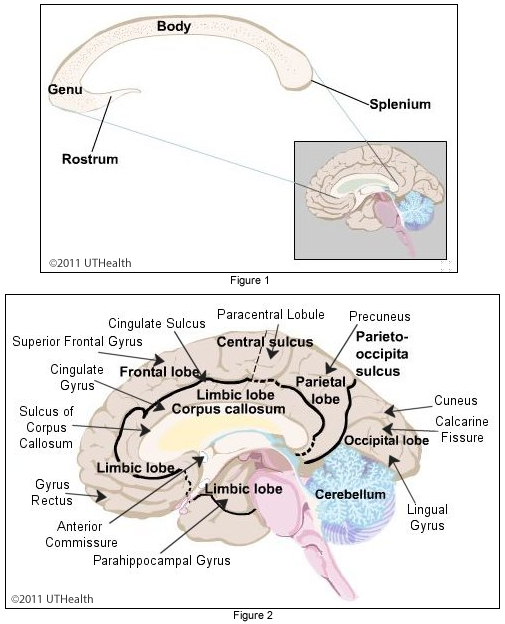Lab 1 - Overview of the Nervous System
Cerebral Lobes - Medial Structures
 On the medial aspect of the hemisected brain, identify the massive band of the corpus callosum. This massive fiber bundle contains commissural fibers which interconnect the two halves of the cerebrum. The corpus callosum consists of (starting rostrally): (1) rostrum, (2) genu, (3) body and (4) splenium (most caudally). Locate the septum pellucidum which normally extends down from the corpus callosum. It forms a midline partition between the two lateral ventricles in the intact brain (it is preserved in only a few hemisected brains).
Below the rostrum is a small fiber bundle known as the anterior commissure.
On the medial aspect of the hemisected brain, identify the massive band of the corpus callosum. This massive fiber bundle contains commissural fibers which interconnect the two halves of the cerebrum. The corpus callosum consists of (starting rostrally): (1) rostrum, (2) genu, (3) body and (4) splenium (most caudally). Locate the septum pellucidum which normally extends down from the corpus callosum. It forms a midline partition between the two lateral ventricles in the intact brain (it is preserved in only a few hemisected brains).
Below the rostrum is a small fiber bundle known as the anterior commissure.
The cingulate gyrus follows the contour of the corpus callosum below, and is separated from it by the sulcus of the corpus callosum. Superior to the cingulate gyrus, the cingulate sulcus separates the cingulate gyrus from the frontal, parietal, and occipital cortices. Anteriorly, the medial surface of the frontal lobes includes extensions of the gyrus rectus, and the superior frontal gyrus. The paracentral lobule consists of the medial extensions of the precentral and postcentral gyri onto the medial surface of the hemisphere. The rostral border of the paracentral lobule is formed by the medial extension of the precentral sulcus and the caudal border by the marginal sulcus (pars marginalis of the cingulate sulcus). The precuneus of the parietal lobe is located between the marginal sulcus and the parieto-occipital sulcus. The cuneus of the occipital lobe is delimited by the parieto-occipital sulcus and the calcarine fissure. Below the calcarine fissure, the lingual gyrus extends inferiorly toward the inferior surface of the cerebrum.
